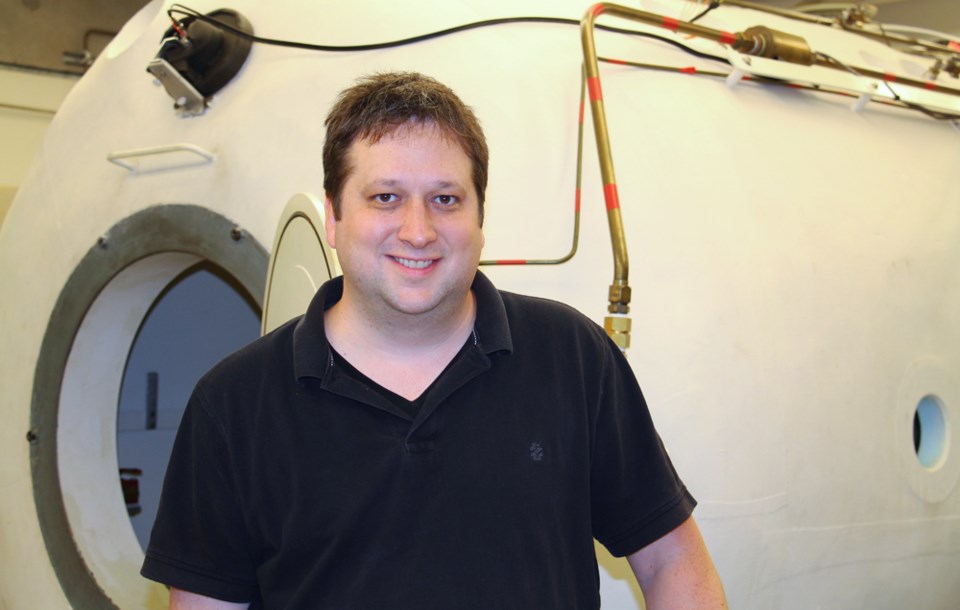Children with autism will soon be travelling up Burnaby Mountain to help test whether sessions in a high-pressure, oxygen-saturated chamber can change their brains and behaviour for the better.
Called hyperbaric oxygen therapy, the treatment has been around for years.
Some families with autistic children say it helps, but not all doctors are convinced there’s enough scientific evidence to prove it works.
Simon Fraser University researcher Sam Doesburg plans to do away with the guesswork.
A neuroscientist and expert in magnetoencephalographic (MEG) brain imaging, Doesburg is the first holder of the SFU Callum Frost Professorship in Translational Research in Autism.
“There’s a whole lot of anecdotal evidence that (hyperbaric oxygen therapy) works, and there have been some studies, but a lot of them don’t have proper controls and they don’t have proper placebo,” Doesburg told the NOW. “There hasn’t really been the kind of study that will lead to solid information for parents but also information that’s going to be suitable for clinicians, like physicians who are involved in the clinical care and policy makers to make decisions about these types of treatments.”
Doesburg started at SFU in September and is still in the planning stages of the study. But come spring, he said, about 24 kids between the ages of about six to 10 will head up to SFU’s Burnaby campus for about 15 one-hour sessions in the university’s hyperbaric chamber.
The increased pressure and pure oxygen in the chamber drives extra oxygen into the brain cells of participants, and that has been reported to lessen the symptoms of autism.
Doesburg will put those reports to the test with a battery of behaviour tests and brain scans before and after the treatment.
“If it’s a home run and hyperbaric oxygenation makes a big change in the brain and it improves the behaviour of many people with autism, then we can provide that evidence to parents, we can provide that evidence to clinicians and we can provide that evidence to policymakers that maybe this is something that should be done.”
The key to Doesburg’s study is the brand new, SFU-led ImageTech Lab currently being installed at Surrey Memorial Hospital.
“It’ll be the only place in Canada west of Toronto, basically, that has a research-dedicated MRI scanner and a research dedicated MEG scanner, which is really the winning combination for this kind of research, where you’re trying to see if a particular treatment can make a real change in functional brain activity.”
Using the lab, Doesburg plans to conduct a series of studies, testing the effectiveness of a range of autism treatments, including applied behavioural analysis and changes to diet.
He said the research – funded by Surrey’s Central City Brewing and Distillery president Darryll Frost and his wife, Lee, whose son Callum has a type of autism – will fill a growing gap in autism research.
“The prevalence of autism has exploded in recent decades,” he said. “What that has done is it’s fueled the invention or the implementation of many many therapies for autism. What hasn’t really kept pace with that is the scientific study to figure out what is really most effective and what’s most effective for specific people with autism.”
Interest in the hyperbaric study has already taken off, even though Doesburg has yet to put out an official call for participants.
“I’m getting phone calls all the time and emails all the time. The hyperbaric lab up at SFU is getting emails all the time and phone calls all the time, so we’ve already got a big running list.”
Burnaby Mountain advantage
Conducting part of his upcoming autism study on a mountain will give SFU researcher Sam Doesburg an advantage.
When the kids in his study enter the hyperbaric chamber at the Environmental Medicine and Physiology Unit at SFU’s Burnaby campus, they’ll have travelled up a mountain to get there.
For the study, one group will breathe normal air and have the pressure increased back to what they experience at sea level, but another group will breathe pure oxygen and have the pressure increased to levels they would only experience deep under water or underground.
Both groups will feel their ears popping, but only one will be getting hyperbaric oxygen therapy.
“It allows us to effectively deliver a true sham or placebo treatment of sea-level air,” said Sherri Ferguson, director of the unit.
Both groups will experience both the treatment and the placebo during the study.



